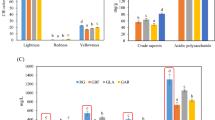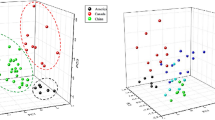Abstract
Ginseng is a widely used medicinal product that grows mainly in Korea, China and America. American ginseng is classified as an endangered species, and so the import and export of this type of ginseng is illegal in certain countries. Due to this restriction it is becoming increasingly important to be able to distinguish between different types of ginseng. FT-Raman spectroscopy has the ability to discriminate between ginseng specimens according to the country of origin and the effects of processing on the ginseng material. The ginsenoside content of ginseng differs in both conformation and concentration depending on the source of the ginseng, which means that ginseng grown in different countries should express unique spectral features. The presence or absence of these features, therefore, could indicate the geographical origin of the sample. Several spectral features were identified for a range of ginsengs, such as a peak at 980 cm−1 that was only found in Chinese ginseng, and the different wavenumber positions of characteristic ginseng bands near 1600 cm−1. This indicates that Raman spectroscopy can be used to pinpoint the origin of an unknown ginseng sample and that it would provide a rapid nondestructive analytical technique for formally discriminating between restricted and permitted imports.










Similar content being viewed by others
References
Woo YA, Cho CH, Kim HJ, Yang JS, Seong KY (2002) Microchem J 73:299
Dixon P (1976) Ginseng. Duckworth, London
Tanaka O, Kasai R, Morita T (1986) Abstr Chin Med 1:130
Lang WS, Lou ZC, But PPH (1993) J Chin Pharm Sci 3:133
Laasonen M (2003) Near infrared spectroscopy, a quality control tool for the different steps in the manufacture of herbal medicinal products. Helsingin yliopisto, Helsinki
Hendra PJ, Jones C, Warnes G (1991) Fourier transform Raman spectroscopy: instrumentation and chemical applications. Ellis Horwood, London
Court WE (2000) Ginseng: the genus panax. Harwood Academic, Amsterdam
Atopkina LN, Uvarova NI, Elyakov GB (1997) Carbohydr Res 303:449
Kaku T, Kawashima Y (1980) Arzneim-Forsch/Drug Res 30–1:936
Kitagawa I, Taniyama T, Hayashi T, Yoshikawa M (1983) Chem Pharmaceut Bull 31:3353
Kim YC, Kim SR, Markelonis GJ, Oh TH (1998) J Neurosci Res 54:123
Ren GX, Chen F (1999) J Agric Food Chem 47:2771
Han ST, Shin CG, Yang BW, Hahm YT, Sohn UD, Im BO, Cho SH, Lee BY, Ko SK (2007) Food Sci Biotechnol 16:281
Yap KYL, Chan SY, Chan YW, Lim CS (2005) Assay Drug Dev Technol 3:383
Robbins CS (2000) Conserv Biol 14:1422
Ngan F, Shaw P, But P, Wang J (1999) Phytochemistry 50:787
Mao JJ, Xu JW (2006) Spectrochim Acta Part A 65:497
Tarakeshwar P, Manogaran S (1995) Spectrochim Acta Part A 51:925
Acknowledgement
American ginseng samples were provided by HM CITES (and originated from London Heathrow airport seizures).
Author information
Authors and Affiliations
Corresponding author
Rights and permissions
About this article
Cite this article
Edwards, H.G.M., Munshi, T. & Page, K. Analytical discrimination between sources of ginseng using Raman spectroscopy. Anal Bioanal Chem 389, 2203–2215 (2007). https://doi.org/10.1007/s00216-007-1605-4
Received:
Revised:
Accepted:
Published:
Issue Date:
DOI: https://doi.org/10.1007/s00216-007-1605-4




